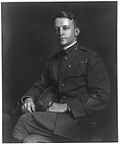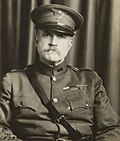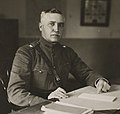| Name | Photo | Date |
|---|
Commander-in-Chief |
| General of the Armies John J. Pershing |  | May 26, 1917 - Aug 31, 1920 |
Chief of Staff |
| Brigadier General James Harbord |  | May 26, 1917 - May 6, 1918 |
| Major General James W. McAndrew |  | May 6, 1918 - May 27, 1919 |
| Major General James Harbord |  | May 27, 1919 - August 12, 1919 |
| Brigadier General Fox Conner |  | August 12, 1919 - August 31, 1920 |
Deputy Chief of Staff |
| Brigadier General LeRoy Eltinge |  | May 1, 1918 - June 30, 1919 |
Assistant Chief of Staff, G1 (Administration) |
| Colonel James A. Logan Jr. | | July 5, 1917 - August 19, 1918 |
| Brigadier General Avery D. Andrews |  | August 19, 1918 - April 23, 1919 |
| Colonel Charles S. Lincoln | | April 23, 1919 - June 1, 1919 |
Assistant Chief of Staff, G2 (Intelligence) |
| Brigadier General Dennis E. Nolan |  | July 5, 1917 - July 6, 1919 |
| Colonel Aristides Moreno | | July 6, 1919 - August 15, 1920 |
Assistant Chief of Staff, G3 (Operations) |
| Colonel John McAuley Palmer |  | July 5, 1917 - December 19, 1917 |
| Brigadier General Fox Conner |  | December 19, 1917 - August 12, 1919 |
| Lieutenant Colonel Albert S. Keugle | | August 12, 1919 - August 15, 1920 |
Assistant Chief of Staff, G4 (Supply) |
| Colonel William D. Connor |  | August 11, 1917 - April 30, 1918 |
| Brigadier General George Van Horn Moseley |  | April 30, 1918 - June 5, 1919 |
Assistant Chief of Staff, G5 (Training) |
| Colonel Paul B. Malone |  | August 11, 1917 - February 14, 1918 |
| Brigadier General Harold B. Fiske |  | February 14, 1918 - July 10, 1919 |
Secretary of the General Staff |
| Colonel Frank R. McCoy |  | September 3, 1917 - May 1, 1918 |
| Lieutenant Colonel James Lawton Collins |  | May 1, 1918 - October 23, 1918 |
| Lieutenant Colonel Thomas W. Hammond | | October 23, 1918 - November 2, 1918 |
| Lieutenant Colonel Albert S. Keugle | | November 2, 1918 - December 10, 1918 |
| Lieutenant Colonel Thomas W. Hammond | | December 10, 1918 - December 28, 1918 |
| Colonel James Lawton Collins |  | December 28, 1918 - July 25, 1919 |
Adjutant General |
| Brigadier General Benjamin Alvord Jr. |  | May 26, 1917 - May 1, 1918 |
| Brigadier General Robert C. Davis |  | May 1, 1918 - August 31, 1920 |
Judge Advocate |
| Brigadier General Walter Augustus Bethel |  | May 26, 1917 - August 15, 1920 |
Inspector General |
| Major General Andre W. Brewster |  | May 26, 1917 - August 15, 1920 |
Chief Quartermaster |
| Colonel Daniel E. McCarthy | | May 26, 1917 - August 13, 1917 |
| Major General Harry L. Rogers |  | August 13, 1917 - January 22, 1919 |
| Brigadier General John M. Carson Jr. |  | January 22, 1919 - April 10, 1919 |
| Colonel John T. Knight | | April 10, 1919 - August 31, 1919 |
Chief Surgeon |
| Brigadier General Alfred E. Bradley |  | May 26, 1917 - May 1, 1918 |
| Major General Merritte W. Ireland |  | May 1, 1918 - October 10, 1918 |
| Brigadier General Walter McCaw |  | October 10, 1918 - July 16, 1919 |
| Colonel Clarence J. Manly | | July 16, 1919 - August 31, 1919 |
Chief Ordnance Officer |
| Brigadier General Clarence C. Williams |  | May 26, 1917 - May 5, 1918 |
| Brigadier General Charles B. Wheeler |  | May 5, 1918 - October 9, 1918 |
| Brigadier General John H. Rice | | October 9, 1918 - August 13, 1919 |
| Colonel Edwin D. Bricker | | August 13, 1919 - August 31, 1919 |
Chief Engineer Officer |
| Brigadier General Harry Taylor |  | May 26, 1917 - July 11, 1918 |
| Major General William C. Langfitt |  | July 11, 1918 - July 16, 1919 |
| Colonel Thomas H. Jackson | | July 16, 1919 - August 31, 1919 |
Chief Signal Officer |
| Brigadier General Edgar Russel | | May 26, 1917 - July 11, 1919 |
| Colonel Roy H. Coles | | July 11, 1919 - August 31, 1919 |
Chief of Air Service |
| Major Townsend F. Dodd |  | May 26, 1917 - June 30, 1917 |
| Lieutenant Colonel William L. Mitchell |  | June 30, 1917 - August 26, 1917 |
| Brigadier General William L. Kenly |  | August 26, 1917 - November 27, 1917 |
| Brigadier General Benjamin Foulois |  | November 27, 1917 - May 29, 1918 |
| Major General Mason Patrick |  | May 29, 1918 - August 31, 1919 |
Provost Marshal General |
| Lieutenant Colonel Hanson E. Ely |  | July 20, 1917 - August 26, 1917 |
| Brigadier General William H. Allaire Jr. |  | August 26, 1917 - September 25, 1918 |
| Brigadier General Harry H. Bandholtz |  | September 25, 1918 - August 31, 1919 |
General Purchasing Agent |
| Brigadier General Charles G. Dawes |  | August 30, 1917 - June 30, 1919 |
Chief of Chemical Warfare Service |
| Brigadier General Amos Fries |  | September 3, 1917 - November 29, 1918 |
| Colonel Edward N. Johnston | | November 29, 1918 - July 5, 1919 |
Director General of Transportation |
| Brigadier General William W. Atterbury |  | September 14, 1917 - May 16, 1919 |
| Brigadier General Frank R. McCoy |  | May 16, 1919 - August 4, 1919 |
| Brigadier General Sherwood Cheney |  | August 4, 1919 - August 31, 1919 |
Director of Motor Transportation |
| Colonel Francis H. Pope | | December 8, 1917 - July 9, 1918 |
| Brigadier General Meriwether L. Walker |  | July 9, 1918 - August 13, 1919 |
| Colonel Edgar S. Stayer | | August 13, 1919 - August 31, 1919 |
Chief of Tank Corps |
| Brigadier General Samuel Rockenbach |  | December 23, 1917 - May 24, 1919 |
Chief of Artillery |
| Major General Ernest Hinds |  | April 29, 1918 - June 12, 1919 |


















































